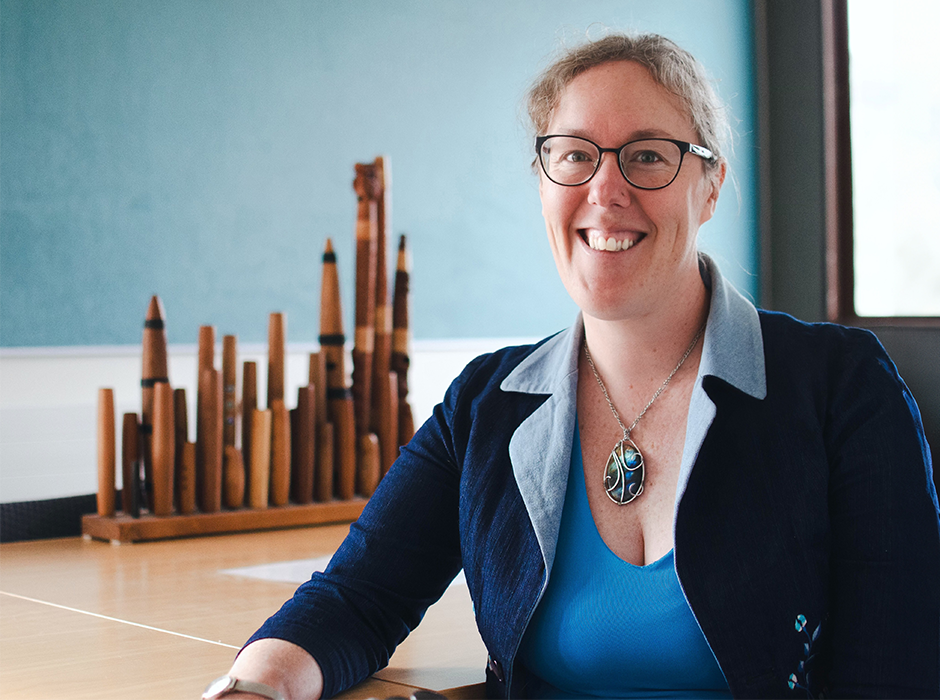
Associate Professor Jennifer Cattermole’s book 'Echoes from Hawaiki: The origins and development of Māori and Moriori musical instruments' will be launched at a special event at the University Book Shop this Thursday. Photos: Mel Stevens
Passion and perseverance have paid off for Associate Professor Jennifer Cattermole as her book on Māori and Moriori instruments (taonga pūoro) is set to be launched this week, a decade after the project was first conceived.
“The book has been quite some time in the works – starting back in 2015 – and it feels like it’s been a real marathon to complete,” Jennifer says.
“I’m just incredibly grateful to the numerous people who’ve been part of its creation. I really hope it will be of use and interest to people in a variety of ways.”
Echoes from Hawaiki: The origins and development of Māori and Moriori musical instruments (Otago University Press) is a comprehensive account of taonga pūoro ancestral musical traditions and instrument-playing techniques. It traces the origins and development of the instruments and how they connect present-day iwi with ancestral knowledge and traditions.
“It also explores how traditional Māori and Moriori musical instruments have developed in response to available materials and evolving cultural needs – from their ancestral origins, through the suppression of their use in nineteenth and early twentieth-century Aotearoa New Zealand, to their revival in the present day,” she says.
Jennifer first became interested in ethnomusicology (the study of music in its social and cultural contexts) as an undergraduate at Otago. She went on to write theses on Aotearoa roots reggae and Fijian stringband music before focussing on Māori and Moriori musical instruments.
“I’ve been learning about, teaching, playing and making taonga pūoro since 2012 – almost for as long as I’ve taught at Otago University – and this research informs my teaching on several papers in the music programme and beyond, such as at local marae and schools.”
Jennifer initially planned to research only Moriori instruments but hit a roadblock when applying for funding.
“Feedback indicated there was just not enough information remaining about Moriori music for a research project to be viable.
“I was keen to reapply and sought advice from archaeologist Ian Barber. Ian has a long-standing relationship with the Hokotehi Moriori Trust (HMT) and also has a history of Marsden-funding success. He suggested that I could broaden the topic to include both Māori and Moriori musical instruments, and that these instruments could be an interesting way to learn more about the immediate geographical origins of the peoples who became Māori and Moriori, and also about cultural adaptation.”
She reached out to then-HMT Chairperson Maui Solomon and they formed a team that also included Ian and taonga pūoro experts James Webster and Alistair Fraser. They were successful and the book largely presents findings from their Marsden-funded project, she says.
Echoes from Hawaiki highlights strong connections between Māori and Moriori musical instruments and those of central East Polynesia – the area sometimes referred to as the 'Hawaiki zone,’ believed to be where the immediate ancestors of Māori and Moriori came from.
“What has been surprising is how similar some Māori and Moriori instruments are to those of West Polynesia and Hawaii. While we might never know for sure whether or not these similarities are proof of cultural contact and, if so, when that contact occurred, it’s intriguing to speculate as to what they mean for the story of Māori and Moriori origins,” Jennifer says.
“It’s also been exciting uncovering and bringing together information about Moriori music in particular, and such an incredible privilege sharing that with the Moriori community through workshops and concerts. The remaining documented knowledge is so fragmentary, and very few living culture bearers remain. I remember really geeking out when finding a name for a type of Moriori flute (pauawau) recorded in a museum catalogue. That name simply isn’t mentioned anywhere else and so is very precious.”
Echoes from Hawaiki will be launched at the University Book Shop this Thursday evening by Professor Michelle Thompson-Fawcett, who is the Poutoko Taiea, Distinguished Chair of Te Ihowhenua, School of Geography, and Manupiki Māori, Associate Dean Māori of Te Kete Aronui, Division of Humanities.
“Jen is a treasured colleague and long-time leading innovator in the tangata Tiriti sphere,” Michelle says.
“She has developed creative and culturally appropriate ways to decolonise the teaching of music performance, particularly in regard to taonga pūoro. Her care and passion for te ara pūoro and the potential to help reconnect Māori with instrument traditions is inspirational.”
Echoes from Hawaiki is an encouraging and motivating book, Michelle says.
“In a field where the published resources are limited, Jen delivers detailed insights into instruments, their whakapapa, locational specificities, and historical narratives. And she does that in a way that is deeply moving and uplifting. I’m sure it will foster our taonga pūoro players of the future.”
Jennifer is also set to give a talk at the Tūhura Otago Museum for Matariki, where people can learn about different types of instruments, their whakapapa, uses, and meanings and where she will demonstrate how to play instruments crafted from things found in the natural environment.She is also part of the research team – led by Science Communication lecturer Gianna Savoie – responsible for putting together an exhibition that opens at the Tūhura Otago Museum on 14 September called Hou rongo: Moriori, Music, Manawa.
“Co-designed with Moriori, this exhibition tells Moriori stories about music and culture, and there are some really cool interactive and multi-sensory exhibits. It’ll be interesting and fun, irrespective of whether you’re young or just young at heart.”
*More about the book, the launch and the talk
– Kōrero by Internal Communications Adviser Laura Hewson




